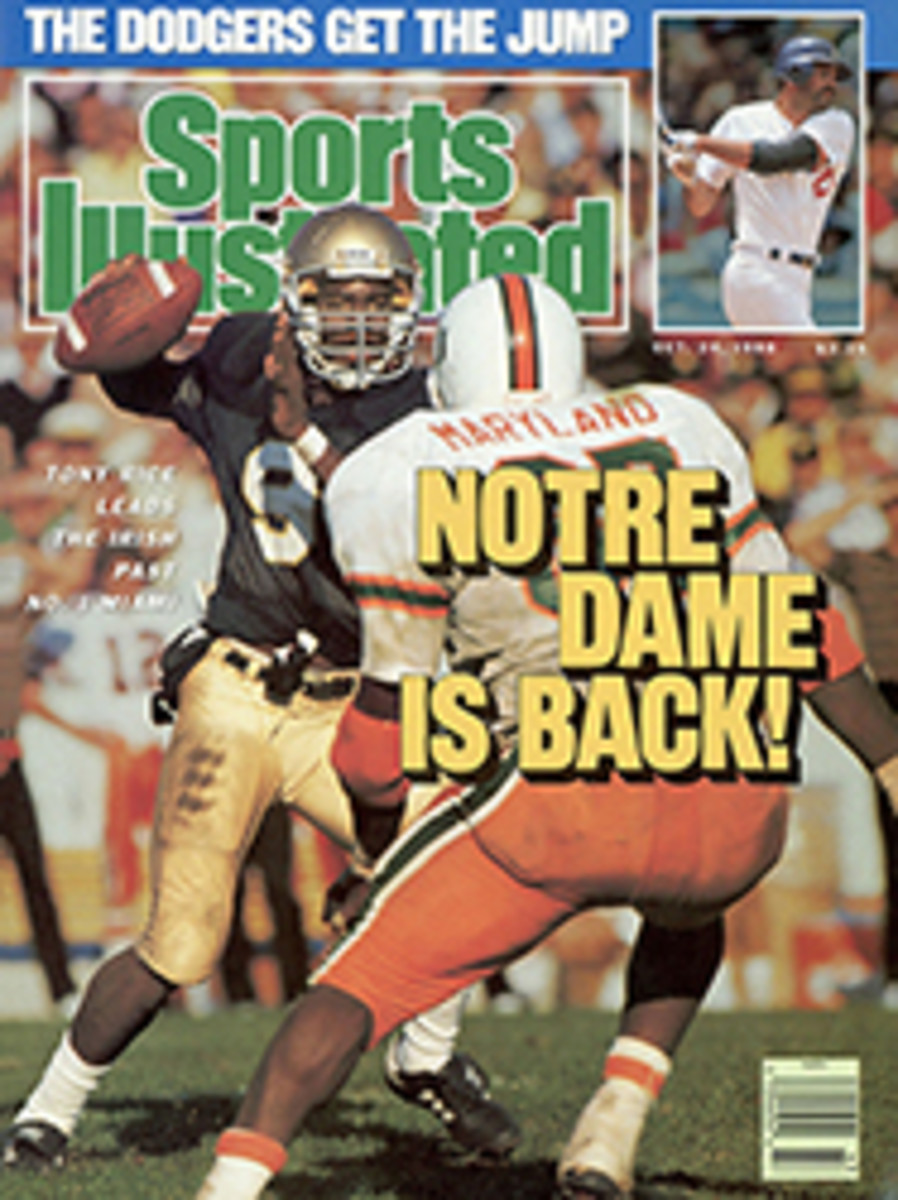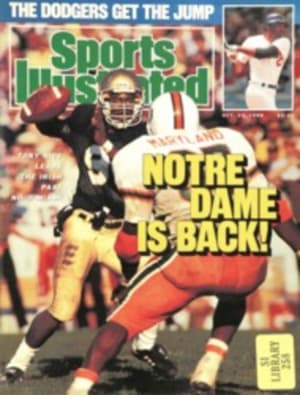
Let's Hear It For the Girl
Personal ensign couldn't wait to get out onto the track at Belmont Park on Sunday for the 50th running of the 1¼-mile Beldame Stakes. As her handlers went through the usual prerace preparations—adjusting her saddle and tightening the girth—the 4-year-old bay filly fought her bit, rolled her eyes and fidgeted. Trainer Shug McGaughey stood nearby looking tense, but his wife, Mary Jane, who is Personal Ensign's exercise rider, was calm. "The more she runs, the less nervous I get," she said.
Only four opponents turned out to take on Personal Ensign in the Beldame. Which was small wonder, considering that Personal Ensign won this race last year and hasn't lost since. In fact, she has never lost. At 16 hands, two inches, she towers over her competition, and in her 11 career victories before Sunday's Beldame she had won by a total of nearly 50 lengths. Of course, the bettors at Belmont sent her off the 1-10 favorite. She didn't disappoint, easily winning by 5½ lengths in a fast 2:01[1/5].
When jockey Randy Romero steered her into the winner's circle, he looked up at the crowd and raised an index finger. No. 1. "She's the best thing I ever rode," he said. "You work all your life to ride something like her." The fans gave the filly a standing ovation, and McGaughey finally remembered to smile. "I'm glad this is over with," he said. "One to go."
The one is the 1‚Öõ-mile Breeders' Cup Distaff on Nov. 5 at Churchill Downs. With a victory in that $1 million outing, Personal Ensign would become the first important American thoroughbred to retire undefeated since the great Colin in 1908; what's more, a win would give her a shot at the Horse of the Year title.
Not bad for a horse who has been racing for the past two years with five screws in her left hind leg. One month after breaking her maiden in September 1986 at Belmont, where she dazzled everyone with a 13-length victory her first time out, Personal Ensign broke the leg during a routine workout. "She went very easy in the work," says McGaughey. "She came back from the track perfect and cooled out just fine, but 30 minutes later she was dead lame in her stall." The X-rays showed a side-to-side break in the long pastern bone. McGaughey summoned veterinarian Larry Bramlage, of Columbus, Ohio, who flew to New York to operate. The filly had five screws implanted in her leg. "We never felt her life was in danger," says McGaughey, "but I sure never thought she'd race again."
Personal Ensign's owner and breeder, Ogden Phipps, wasn't so sure. The filly, a daughter of Private Account by Grecian Banner, took 11 months off and came back to the track late in her 3-year-old season. She hit the ground running in September 1987, winning at Belmont by 3¾ lengths, and she hasn't looked back since. She beat the boys in the Whitney Handicap at Saratoga in August, and she has beaten every filly who has challenged her. That list includes the 3-year-old Winning Colors, the giant roan who outran 16 males to win the Kentucky Derby. The two fillies met in the Maskette Mile at Belmont on Sept. 10, and both performed brilliantly, Personal Ensign prevailing by three quarters of a length.
Their rematch will be in the Distaff on Breeders' Cup day in Louisville. "You've got two superstars. One is the Derby winner and the other is undefeated, so the race has got romance to it right there," says Winning Colors' trainer, D. Wayne Lukas.
Still, the $3 million Breeders' Cup Classic will be run about two hours after the Distaff, and if Alysheba wins the former and Personal Ensign the latter, another confrontation will move to the fore: Who is Horse of the Year? An Alysheba victory would lift the 4-year-old colt past John Henry ($6,597,947) as the top money winner of all time, an enormous achievement. Then again, Personal Ensign would be unbeaten. There undoubtedly will be much clashing of opinion, and rest assured that much will made of the fact that Personal Ensign is a filly.
There are few things that arouse the emotions of race fans more than the equine members of the so-called weaker sex, especially when they take on the boys and beat them. Conquering the colts is what raises the stature of a good filly to greatness. But it also causes a lot of confusion. Horsemen and racing fans often equate a filly with a woman and a colt with a man; it's a given that human males are physically stronger than females, but the discrepancy isn't nearly as great in the equine world. "The top woman sprinter, like Flo-Jo, can't beat a Ben Johnson, and the best woman golfer can't beat Greg Norman," says McGaughey. "People relate that to colts and fillies. But it doesn't work that way."
Dr. Benson Martin, a veterinarian at the New Bolton School of Veterinary Medicine in Pennsylvania, says, "Generally, colts mature earlier and tend to be more precocious than the fillies. However, fillies like Winning Colors and Personal Ensign are obviously females who have come into their own very early. I don't think of them as freaks. They're exceptional athletes."
Most trainers won't risk sending a filly against colts and possible defeat, because there's no need to. There are plenty of stakes races in North America exclusively for females, in which a filly can prove she can run and can pick up generous purses along the way.
Also, fillies generally don't have to race as often or for as long a time as colts do. This is a matter of economics and also a matter of the birds and the bees. Any good thoroughbred is raced not only to win purses but also to prove his or her value as a potential parent of top runners. But whereas a stallion at stud can contribute to the genetic makeup of as many as 50 foals a year, a mare can produce only one offspring in that time.
Simple arithmetic says that breeders can thrive with only a few exceptional stallions but need many quality broodmares. Says LeRoy Jolley, trainer of 1980 Kentucky Derby-winning filly Genuine Risk, "The difference between the two sexes as far as horse racing goes is that a filly only has to win one major stakes race in her life [to demonstrate exceptional breeding potential], whereas a colt, to be valuable as a stallion, has to be a top-rated performer almost every race of his life. So the pressures and the criteria for success are much different."
Furthermore, for a filly to make it to the top, she must not only beat the other horses on the track, but also overcome long-standing prejudices that have limited the role of fillies in American racing. Among them:
1) A filly is too delicate to race against bigger, stronger colts who are likely to intimidate and overpower her. Big, beautiful and nearly coal black, Ruffian was the first filly media star, but in a match race in 1975 with the colt Foolish Pleasure, winner of that year's Kentucky Derby, Ruffian snapped a leg and had to be put down. Despite Ruffian's many successes, her demise may have been a significant setback for fillies' lib because, in the view of some, that tragic race serves to illustrate what can happen when you send a girl out to play with the boys. But, of course. Ruffian's fatal misstep had nothing to do with being a filly.
2) A hard-raced filly will make a poor broodmare because she has left most of her energies on the racetrack. In 1980 Genuine Risk became only the second filly to win the Kentucky Derby. (Regret was the first, in 1915.) In fact, Genuine Risk was the first filly in 21 years even to enter the race—and her trainer, Jolley, and owners, Bert and Diana Firestone, debated for days over whether to send her. The owners won. Two years after her Derby triumph, Genuine Risk was bred to Secretariat, but her foal was born dead and she has remained barren ever since. This confirmed for many horsemen the adage that a race-worn filly will not be a good producer. Others scoff at the notion. "I think a healthy, fit mare has a better chance of getting in foal than one that's been lying around and doesn't have any muscle tone," says Lukas. He should know. His great filly Lady's Secret—who was raced hard, beat colts and was voted Horse of the Year in 1986—is in foal to Alydar.
3) When a filly is "horsey," or in season, she's undependable and probably will not race well. This may be true, but fillies are in season for relatively short periods of time. Besides, although they don't like to talk about it, trainers have been giving hormones to fillies for years to control that variable.
Attitudes about fillies are changing—but slowly. Lukas, who has had remarkable success with fillies and has been the top trainer in the U.S. for the past five years, may well have been the catalyst. He races his fillies hard, often against males. "Two or three years ago I was criticized for racing my fillies against colts," he says. "But now it's accepted. It enhances the reputation and value of a filly if she can jump up and beat a colt like Forty Niner or Gulch. After all, we breed them to race. I think we should develop their star status before they go off to the breeding shed."
With 50,000 thoroughbreds born each year in the U.S.—and with a yearling sales market that has fallen in recent years—buyers consider more than just a mare's genes. They take a close look at her racing record too. John Williams, who was general manager of Spendthrift Farm from 1976 to '84 and who now sells thoroughbreds as an agent, says, "Pedigree is nothing more than a tabulation of performance in a family. And equine athletes have a better chance of producing an athlete than those who were not athletic. People are buying horses who are out of mares who were good runners themselves or are good producers. We'll probably see fillies kept on the racetrack longer in the future. They've got to prove themselves. They've got to be runners."
After the Distaff, Personal Ensign will be retired to begin her breeding career. And if her offspring come up for sale in the years to come, there will be no doubt that their mother was a runner.
PHOTO
JERRY COOKE
After the Breeders' Cup, Personal Ensign will retire to the pastoral life of a broodmare.
PHOTO
SKIP DICKSTEIN
Personal Ensign beat another extraordinary filly, Winning Colors, in the Maskette Mile.
PHOTO
JERRY COOKE
Gender played no part in the misstep that resulted in Ruffian's being put down in '75.
PHOTO
NEIL LEIFER
[See caption above.]

